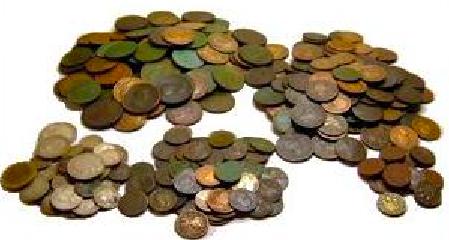Skip over navigation



Or search by topic
Number and algebra
Geometry and measure
Probability and statistics
Working mathematically
Advanced mathematics
For younger learners
Coins (2)
Age 7 to 11
Challenge Level 






Most countries have their own currency - coins and notes.
How many different values of coins and/or notes do you have in your country?
Let's take the USA as an example - using dollars \$ and cents ¢.
One dollar is equal to 100 cents.
Coins: 1 ¢, 5 ¢ , 10 ¢ , 25 ¢ , \$1
Banknotes: \$1 , \$5 , \$10 , \$20, \$50 , \$100 .
For another example let's take India - using Rupee ₹ and Paise .
.
One Rupee is equal to 100 Paise.
Coins 50 & ₹1, ₹2, ₹5, ₹10,
& ₹1, ₹2, ₹5, ₹10,
Notes ₹5, ₹10, ₹20, ₹50, ₹100, ₹500, ₹1000
Using American currency
What is the smallest number of notes and coins (and what are they) which make a total of 12 dollars 83 cents?
What is the largest number of different notes and coins you can use to make 12 dollars 83 cents?
Using Indian currency
What is the smallest number of notes and coins (and what are they) which make a total of ₹1260 ?
What is the largest number of different notes and coins you can use to make ₹1260 ?
How many different values of coins and/or notes do you have in your country?
Let's take the USA as an example - using dollars \$ and cents ¢.
One dollar is equal to 100 cents.
Coins: 1 ¢, 5 ¢ , 10 ¢ , 25 ¢ , \$1
Banknotes: \$1 , \$5 , \$10 , \$20, \$50 , \$100 .
For another example let's take India - using Rupee ₹ and Paise
 .
.One Rupee is equal to 100 Paise.
Coins 50
 & ₹1, ₹2, ₹5, ₹10,
& ₹1, ₹2, ₹5, ₹10,Notes ₹5, ₹10, ₹20, ₹50, ₹100, ₹500, ₹1000
Using American currency
What is the smallest number of notes and coins (and what are they) which make a total of 12 dollars 83 cents?
What is the largest number of different notes and coins you can use to make 12 dollars 83 cents?
Using Indian currency
What is the smallest number of notes and coins (and what are they) which make a total of ₹1260 ?
What is the largest number of different notes and coins you can use to make ₹1260 ?
Photograph Acknowledgement
http://www.psdetecting.com/
http://www.psdetecting.com/
You may also like
Christmas Shopping
Vera is shopping at a market with these coins in her purse. Which things could she give exactly the right amount for?
Buying a Balloon
Lolla bought a balloon at the circus. She gave the clown six coins to pay for it. What could Lolla have paid for the balloon?

